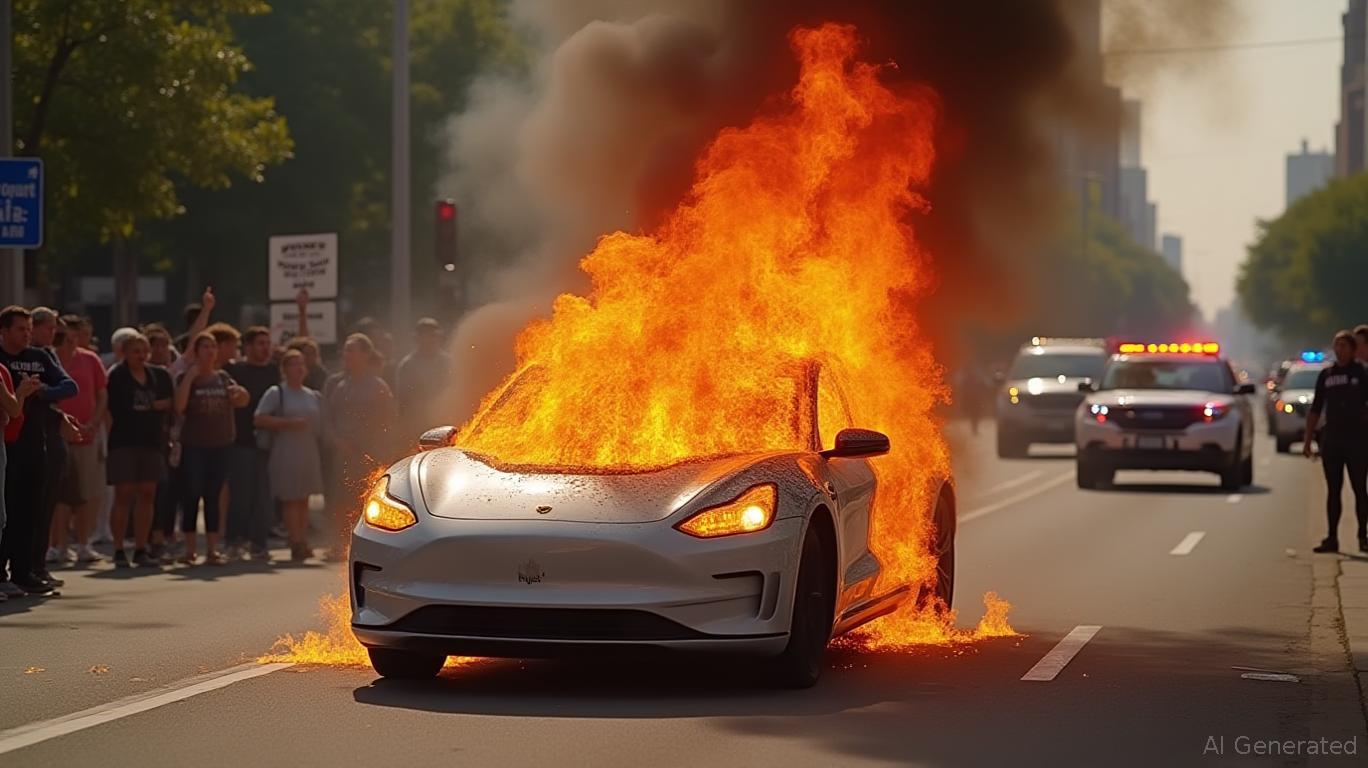Waymo's Los Angeles Setbacks: A Wake-Up Call for Autonomous Tech Investors
The rise of autonomous vehicles (AVs) has long been framed as an inevitability, yet the June 2025 vandalism of Waymo's self-driving fleet in Los Angeles—and the political firestorm that followed—reveals how fragile this vision remains. As protests against federal immigration raids devolved into targeted attacks on Waymo's robotic taxis, the incident underscored a critical truth: the path to mass AV adoption is fraught with social, geopolitical, and infrastructural risks that could derail even the most advanced technologies. For investors, this is no longer a theoretical concern. The stakes are now tangible, and the calculus for backing EV/AV firms must account for their resilience to human variables as much as technical ones.
The LA Incident: A Microcosm of Broader Risks
On June 7–8, 2025, anti-ICE protests in downtown Los Angeles turned violent, with demonstrators targeting Waymo's self-driving cars. At least five vehicles were set ablaze, their lithium-ion batteries releasing toxic fumes, while others were vandalized with shattered windows and spray-painted slogans. The attacks occurred alongside road closures and National Guard deployments ordered by President Trump—a controversial move that pitted federal authority against local governance. Waymo temporarily halted operations in key protest zones, citing safety risks from burning batteries and ongoing unrest.

This incident isn't an isolated anomaly. Waymo faced similar vandalism in 2023 and 2024, but the 2025 attacks coincided with heightened geopolitical volatility. The National Guard's deployment—unprecedented without a governor's consent—exposed how AV infrastructure can become collateral in political battles. For investors, the message is clear: AVs are not just technical systems but social systems, vulnerable to public sentiment, regulatory shifts, and even acts of civil disobedience.
Three Pillars of Risk for AV/ EV Firms
- Public Acceptance Gaps
Waymo's Los Angeles vandalism reflects a growing divide between tech optimism and societal skepticism. While AVs promise efficiency, their physical presence on streets makes them targets for protests—whether due to anti-immigration sentiment (as in this case) or broader distrust of automation. The risk isn't just physical damage; it's the erosion of public trust. A single viral video of an AV being torched can amplify fears of job displacement or privacy invasions, deterring adoption.
Note: A hypothetical dip in GOOGL's stock during the incident would validate market sensitivity to such risks.
Geopolitical Overreach
The federalization of California's National Guard—without Governor Newsom's consent—highlighted how political agendas can disrupt AV operations. Imagine a scenario where a government, facing unrest, restricts AV movement to control crowds. Or worse, foreign adversaries target AV supply chains as part of hybrid warfare. AV firms reliant on concentrated markets (e.g., Waymo's focus on U.S. urban centers) face outsized exposure to such risks.Infrastructure Fragility
AVs depend on stable urban environments—predictable traffic, unmolested charging stations, and government cooperation. The LA protests shut down critical routes, forcing Waymo to curtail service. In less-developed regions, similar disruptions could cripple AV networks. Investors must ask: Do companies have backup fleets, alternative charging networks, or partnerships to navigate sudden infrastructure collapse?
Investment Playbook: Prioritize Resilience and Diversification
The LA incident isn't a death knell for AVs—but it should be a wake-up call to reassess risk profiles. Here's how to invest wisely:
1. Look Beyond the Tech
Focus on firms with crisis management protocols:
- Are they developing tamper-resistant vehicle designs?
- Do they have contingency plans for public backlash (e.g., rapid relocations of fleets)?
- How do they engage with communities to preempt distrust?
Waymo's response—emphasizing “road safety” and cooperating with investigations—is a start, but competitors like Cruise (GM) or Argo AI (Ford) may offer better safeguards.
2. Diversify Geographic Exposure
Avoid companies overly reliant on politically volatile regions. Waymo's heavy LA focus amplified its risks; contrast this with Tesla's global footprint, which spreads regulatory and social risks.
Regions with lower social unrest and stronger regulatory frameworks (e.g., Norway) may be safer bets for AV infrastructure investment.
3. Leverage Partnerships with Governments
Firms collaborating with municipalities to co-design AV policies (e.g., Ford's partnerships in Europe) reduce the chance of being caught in regulatory crossfires. Waymo's silence on federal vs. state tensions during the LA protests suggests a lack of such proactive engagement.
4. Hedge with “Hybrid” Players
Companies like Toyota or VW, which balance AV innovation with traditional vehicle sales, offer diversification. Their broader revenue streams cushion against AV-specific disruptions.
Conclusion: AVs Are Only as Strong as Their Social Foundations
The LA protests reveal a stark reality: autonomous vehicles are only as resilient as the societies they operate in. For investors, this means moving beyond metrics like range or battery life to evaluate social capital—the ability of firms to navigate protests, political strife, and public distrust.
In the short term, Waymo's stock may recover, but the incident underscores a systemic vulnerability. The winners in this space won't just be the technically superior but the socially agile. Investors should demand transparency about crisis preparedness, geographic diversification, and community engagement. Those who don't may find their portfolios as flammable as a lithium-ion battery in a riot.
Final Call to Action: Favor AV/ EV firms with diversified geographies, government partnerships, and proven crisis management. For now, Waymo's LA setback is a cautionary tale—don't let your portfolio become the next target.

Comments
No comments yet